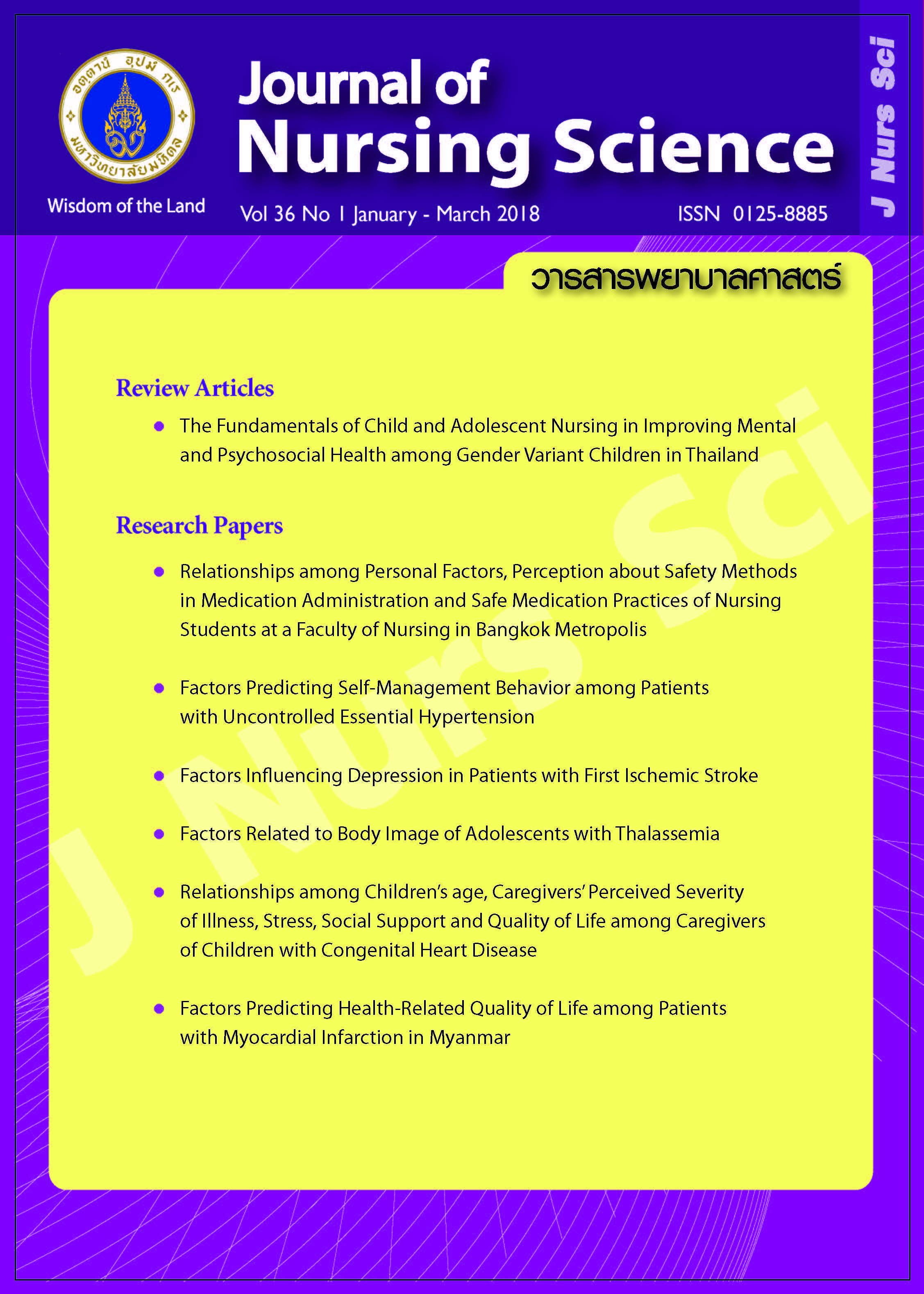Factors Related to Body Image of Adolescents with Thalassemia
Main Article Content
Abstract
Purpose: This study aimed to examine the relationships between related factors: age, gender, perceived reactions from others, social support, and body image of adolescents with thalassemia.
Design: Correlational study.
Methods: The study sample included 126 patients, aged between 13-18 years, who attended Pediatric Hematology Clinics in three tertiary care public hospitals. The subjects were recruited by convenience sampling. Data were collected using questionnaires: a demographic data form, perceived reactions from others questionnaire, social support questionnaire, and body image of adolescents with thalassemia questionnaire. Data were analyzed using descriptive statistics, Pearson’s correlation coefficient and Chi-square.
Main findings: The study results indicated that adolescents with thalassemia perceived their body image at a poor level. Patient’s age was negatively correlated with body image (r = - .18, p < .05). Two factors were positively correlated with body image; that is, perceived reactions from others (r = .45, p < .01) and social support (r = .20, p < .05). However, gender was not correlated with body image in adolescents with thalassemia (χ2 = .74, p = .39).
Conclusion and recommendations: Adolescents with thalassemia had poor body image and the correlated factors included age, perceived reaction from others, and social support. Healthcare providers, especially professional nurses, should promote caregivers, family members and other related persons to have good understanding towards these adolescents and express positive reaction as well as provide sufficient social support to them in all aspects. These would assist adolescents with thalassemia to perceive better body image.
Article Details
Copyright Notice: Nursing Science Journal of Thailand has exclusive rights to publish and distribute the manuscript and all contents therein. Without the journal’s permission, the dissemination of the manuscript in another journal or online, and the reproduction of the manuscript for non-educational purpose are prohibited.

Disclaimer: The opinion expressed and figures provided in this journal, NSJT, are the sole responsibility of the authors. The editorial board bears no responsibility in this regard.
References
2. Viprakasit V. Comprehensive management for thalassemia. Journal of Hematology and Transfusion Medicine. 2013;23(4):303-20. (in Thai).
3. The Bureau of Policy and Strategy, Ministry of Public Health. Summary of illness 2015. Bangkok: WVO Officer of Printing Mill; 2015. p.20-21. (in Thai)
4. Bryant R. The child hematologic or immunologic dysfunction. In: Hockenberry MJ, Wilson D, editors. Wong’s nursing care of infant and children. St.Louis, Missouri: Mosby; 2011. p.929-47.
5. Rower JS, Jame SR, Nelson KA, Ashwill JW. The children with a hematologic alteration. In: Kindle J, editor. Nursing care of children: principles and practice. St.Louis, Missouri: Elsevier; 2013. p.581-90.
6. Khurana A, Katyal S, Marwaha RK. Psychosocial burden in thalassemia. Indian J Pediatr. 2006;73(10):877-80.
7. Gharaibeh H, Amarneh BH, Zamzam SZ. The psychological burden of patients with beta thalassemia major in Syria. Pediatr Int. 2009;51(5):630-6.
8. El Rassi F, Cappellini MD, Inati A, Taher A. Beta-thalassemia intermedia: An overview. Pediatr Ann. 2008;37(5):322-8.
9. Sapphakun K, Poysungneon P, Sosome B. Quality of life of early adolescent people with thalassemia: the study from gender perspective. APHEIT Journal. 2011;17(2):87-93. (in Thai).
10. Sitthikhungaew M, Chintanadilok N, Sangperm P, Pornchaikate Au-Yeong A. relationship between perceived stressors and depressive symptoms in adolescents with thalassemia. Journal of Nursing Science. 2012;30(3):25-35. (in Thai).
11. Price B. Body image in adolescents: insights and implications. Pediatr Nurs. 2009;21(5):38-44.
12. Quick V. Social theory applied to body image and chronic illness in youth. Am J Lifestyle Med. 2013;8(1):15-20.
13. Smolak L. Body image in children and adolescents: where do we go from here? Body Image. 2004;1(1):15-28.
14. Wertheim EH, Paxton SJ. Body image development in adolescent girls. In: Cash TF, Smolak L, editors. Body image: a handbook of science, practice, and prevention. New York: Guilford Press; 2011. p.76-84.
15. Larouche SS, Chin-Peuckert L. Changes in body image experienced by adolescents with cancer. J Pediatr Oncol Nurs. 2006;23(4):200-9.
16. Wu LM, Chin CC. Factors related to satisfaction with body image in children undergoing chemotherapy. Kaohsiung J Med Sci. 2003;19(5):217–24.
17. Price B. A model for body-image care. J Adv Nurs. 1990;15(5):585-93.
18. Suwanbumrong J. Factors related to body image of school-aged leukemic children. Songklanagarind Journal of Nursing. 1996;16(3):1-8. (in Thai).
19. Kriwan Y. Statistics and SPSS program. Bangkok: CU Print; 2012. p.88-92. (in Thai).
20. Thanbuasawan D. Relationship between social support and self-esteem of early adult thalassemia patients [master’s thesis]. Chiang Mai: Chiang Mai University; 1997. 98 p. (in Thai).
21. Cobb S. Presidential Address-1976. Social support as a moderator of life stress. Psychosom Med. 1976;38(5):300-14.
22. Cheewapoonpol B. Relationship between personal factors, fear of reaction of significant persons, coping strategies, social support, and body image of post mastectomy patients. Kuakarun Journal of Nursing. 2006;13(2):9-12. (in Thai).
23. Chaichana S, Pumchan P. Effect and adjustment of thalassemia disease patients in early adulthood: a case study of The Thalassemia Club of Chulalongkorn Hospital. Journal of Graduate Studies Valaya Alongkron Rajabhat University. 2015;9(3):58-70. (in Thai).

